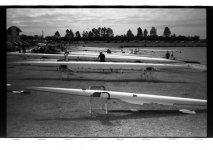Mark T
Established
Dear Roger,
I recently bought some expired Agfa APX 25 film, the first roll of which I developed yesterday. Unfortunately the developed film lacked a lot of contrast and the images appeared quite blurred, as seen below. I knew it was not a problem of imperfect focus, or with my scanning (although that isn't very good). I wasn't sure if the problem was with the film or with my development. I was at the end of my developer and was therefore having to use it twice, compensating with +15% time.
Since I have a couple of your very helpful books, I had a look through your website to see what I could find. Somewhere in there I came across your comments describing the use of expired film, and the potential faults they can have. These faults seemed reflected in my negatives and my problem seemed solved, so thank you very much for that.
I then continued to read you article "Choosing Black and White Films" and that's where I am hoping for some clarification. I have been using HP5+ and DD-X quite a bit recently. In your article you mention that you rate HP5+ at 320 (in camera meter), then develop the film in DD-X, presumably at Ilford's recommended temp/time for a rating of 400 in DD-X? All of which is understandable and okay. However, where I am getting lost, is where you say the film ends up at an equivalent of ISO 650. Does this mean that the negative density has built up beyond that of the ISO for 400 speed film? Does this not mean the film is therefore over-developed/over-exposed? If that is the case, why would you seek that result? I could be way off and have totally missed your point but I can't get my head around what is going on.
Thanks Mate,
Mark
I recently bought some expired Agfa APX 25 film, the first roll of which I developed yesterday. Unfortunately the developed film lacked a lot of contrast and the images appeared quite blurred, as seen below. I knew it was not a problem of imperfect focus, or with my scanning (although that isn't very good). I wasn't sure if the problem was with the film or with my development. I was at the end of my developer and was therefore having to use it twice, compensating with +15% time.
Since I have a couple of your very helpful books, I had a look through your website to see what I could find. Somewhere in there I came across your comments describing the use of expired film, and the potential faults they can have. These faults seemed reflected in my negatives and my problem seemed solved, so thank you very much for that.
I then continued to read you article "Choosing Black and White Films" and that's where I am hoping for some clarification. I have been using HP5+ and DD-X quite a bit recently. In your article you mention that you rate HP5+ at 320 (in camera meter), then develop the film in DD-X, presumably at Ilford's recommended temp/time for a rating of 400 in DD-X? All of which is understandable and okay. However, where I am getting lost, is where you say the film ends up at an equivalent of ISO 650. Does this mean that the negative density has built up beyond that of the ISO for 400 speed film? Does this not mean the film is therefore over-developed/over-exposed? If that is the case, why would you seek that result? I could be way off and have totally missed your point but I can't get my head around what is going on.
Thanks Mate,
Mark


